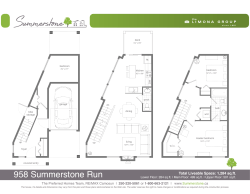
ayout 1
HOMEMAKER In the third of her four-part series on decorating decisions made easy, designer KRISTINE BONNICI enlightens us on how to electrify our homes. Let there be light! POWER HOUSE t is never too early to start thinking about light and power points. In order to add power and light successfully to an interior, you need to design a comprehensive light plan at the very start of the project. There are many important safety regulations that must be followed during installation, and only a qualified electrician should be entrusted with the job. The appearance of light switches and sockets has come a long way in recent years and it is possible to find different colours and profiles to suit most interiors. Unfortunately, in modern apartment blocks, not enough thought is given to the light and power plan, with only basic preparations included. They usually consist of a central light point and two power points per room. Those allotted for the kitchen are generally more generous, with a maximum of four! To anyone who has lived in a welldesigned home, it is immediately obvious that this basic plan is inadequate and would need alteration. A successful light and power plan takes into account the natural light of the room, the position and orientation of the apertures, the location of the furniture, the functions to be performed in it, the style of the interior and the lifestyle of the occupants. Power points need to be planned and not simply placed haphazardly around the room. Lighting and power need to be planned together with the furniture plan. In a main bedroom, power points are required on either side of the bed, behind the dressing table and chest of drawers, and also behind the wardrobe for connecting interior wardrobe lighting. Consider the height of each piece of furniture so that unsightly sockets and plugs can be concealed. Decide whether the bedside table lamps are to be controlled by a wall switch, or by a local switch attached to the flex of the lamp. Many charge their mobiles and laptops in the bedroom, so allow for sockets for this too. I In a child’s bedroom, the desk needs to be adequately supplied with power for the computer, PlayStation, etc… For safety reasons, avoid the need for trailing wires and the use of extension cords. With adequate preparation and careful planning, it is also possible to avoid trailing wires from a game console to the monitor. The study also requires careful planning. Decide on the position of the desk and ensure that there are adequate power points for the computer, fax, printer, scanner and any other equipment you may need. Think about the location of reading and table lamps. The bathroom requires power supply for the water heater, bathroom heater, shaver, heated towel rail and a dedicated point for a hair dryer if required. There are a number of safety requirements regarding the installation of power points in the bathroom and these should be carefully adhered to. The kitchen is the room that normally requires more power points than any other in the house. Plan the layout of the cupboards and points for all the appliances. It is safer to allocate one point per appliance, rather than attaching multiple plugs to one socket, and don’t forget to add a power point for the cooker hood. Your electrician will advise you regarding isolated points for electrical appliances, such as the cooker and water heater. Install double socket points along the working surface in order to avoid trailing wires when using kitchen appliances. Most accidents occur in the home and many can be avoided. Decide on the most likely position for the electric kettle and ensure you have a power point for this appliance too. The living and sitting room require a great deal of planning. First of all, decide on the position of the TV and any other focal points that may require an electrical supply, such as a fireplace. Then decide on the size and location of the sofas. Add occasional tables, side tables and the coffee table to your layout, and finally, decide on any additional furniture, such as bookshelves, storage for drinks, etc… Power points may need to be added to the centre of the room at floor level to plug in any lights on the side of the sofa, or on the coffee table. The TV and audio-visual area requires adequate power. Some audio-visual systems require an isolated power switch and it is advisable to get input from the supplier. Many home owners are opting for a plasma TV. Decide on the size and location so that the wires can be concealed behind the screen. Think about connections to the subwoofer, DVD player and speakers. Add connections for cable, digital and satellite as required. Power points in the dining room are usually required for table and floor lamps. Some households also use food-warming equipment and this also requires an electrical supply. Power points in a hallway are also required for lamps and a cordless telephone. When working on the plan, think about the location of air-conditioners, water heaters, water pumps, electric heaters, dehumidifiers, telephone sockets, intercom, alarm, sound systems, computers and emergency lights. Think about likely positions for ceiling and floor fans. Add points that you may need when using a vacuum cleaner, for the Christmas tree and any other seasonal decorations that require an electrical socket. Design the layout for any power points you may need in the garden and in any outside spaces, using waterproof sockets for the exterior. Installing power and light in a home is expensive. Careful planning avoids any expensive mistakes and ensures that you spend money where it is needed. Kristine Bonnici can be contacted on 7988 5657, or design@kristinebonnici.com pink 67
© Copyright 2025












